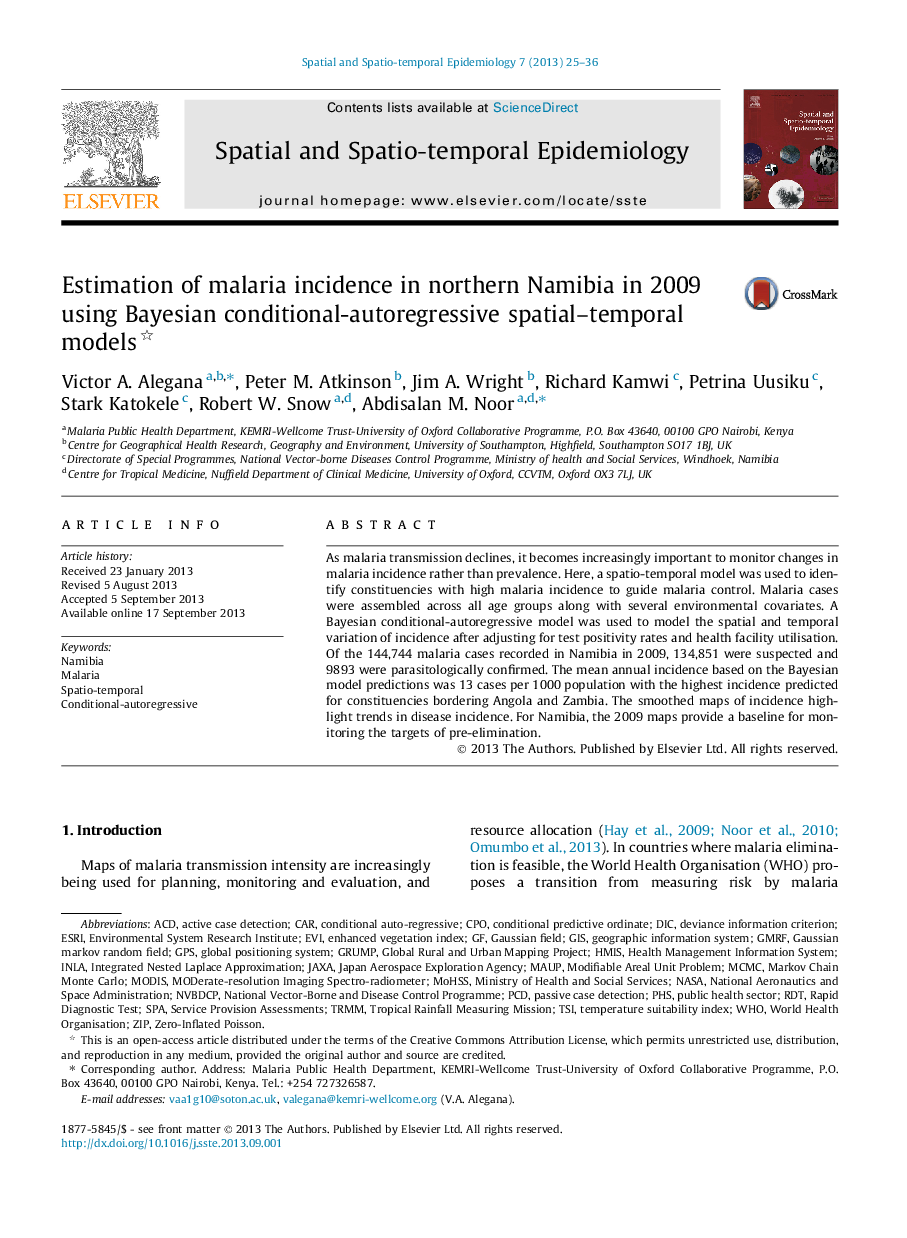| کد مقاله | کد نشریه | سال انتشار | مقاله انگلیسی | نسخه تمام متن |
|---|---|---|---|---|
| 7496183 | 1485770 | 2013 | 12 صفحه PDF | دانلود رایگان |
عنوان انگلیسی مقاله ISI
Estimation of malaria incidence in northern Namibia in 2009 using Bayesian conditional-autoregressive spatial-temporal models
ترجمه فارسی عنوان
برآورد شیوع مالاریا در شمال با نامیبیا در سال 2009 با استفاده از مدل های فضایی-زمانی
دانلود مقاله + سفارش ترجمه
دانلود مقاله ISI انگلیسی
رایگان برای ایرانیان
کلمات کلیدی
Public health sectorINLASPAGMRFACDZIPEVIPHSPCDMAUPRDTTRMMCPOJAXADICTSIESRIMCMCHMIsJapan Aerospace Exploration Agency - آژانس اکتشاف هوافضا ژاپنSpatio-temporal - اسپکتیو زمانیکهMODIS - تابشسنج طیفی تصویربرداری با وضوح متوسط یا MODIS rapid diagnostic test - تست تشخیص سریعMarkov chain Monte Carlo - زنجیره مارکف مونت کارلوWorld Health Organisation - سازمان بهداشت جهانیnational aeronautics and space administration - سازمان ملی هوانوردی و فضاییGIS - سامانه اطلاعات جغرافیاییGPS - سامانه موقعیتیاب جهانیGeographic information system - سیستم اطلاعات جغرافیاییHealth Management Information System - سیستم مدیریت اطلاعات بهداشتیGlobal Positioning System - سیستم موقعیت یاب جهانیEnhanced Vegetation Index - شاخص رشد گیاهیTropical Rainfall Measuring Mission - مأموریت سنجش بارش باران گرمسیریCAR - ماشینMalaria - مالاریاModifiable areal unit problem - مشکل واحد محدوده قابل تغییرdeviance information criterion - معیار انحراف اطلاعاتGaussian Markov random field - میدان تصادم گاوسی مارکوفGaussian field - میدان گاوسیNASA - ناساNamibia - نامیبیاZero-inflated Poisson - پواسون صفر بادیWHO - کهIntegrated nested Laplace approximation - یکپارچه تقسیم لاپلاس ناساز
موضوعات مرتبط
علوم پزشکی و سلامت
پزشکی و دندانپزشکی
سیاست های بهداشت و سلامت عمومی
چکیده انگلیسی
As malaria transmission declines, it becomes increasingly important to monitor changes in malaria incidence rather than prevalence. Here, a spatio-temporal model was used to identify constituencies with high malaria incidence to guide malaria control. Malaria cases were assembled across all age groups along with several environmental covariates. A Bayesian conditional-autoregressive model was used to model the spatial and temporal variation of incidence after adjusting for test positivity rates and health facility utilisation. Of the 144,744 malaria cases recorded in Namibia in 2009, 134,851 were suspected and 9893 were parasitologically confirmed. The mean annual incidence based on the Bayesian model predictions was 13 cases per 1000 population with the highest incidence predicted for constituencies bordering Angola and Zambia. The smoothed maps of incidence highlight trends in disease incidence. For Namibia, the 2009 maps provide a baseline for monitoring the targets of pre-elimination.
ناشر
Database: Elsevier - ScienceDirect (ساینس دایرکت)
Journal: Spatial and Spatio-temporal Epidemiology - Volume 7, December 2013, Pages 25-36
Journal: Spatial and Spatio-temporal Epidemiology - Volume 7, December 2013, Pages 25-36
نویسندگان
Victor A. Alegana, Peter M. Atkinson, Jim A. Wright, Richard Kamwi, Petrina Uusiku, Stark Katokele, Robert W. Snow, Abdisalan M. Noor,
